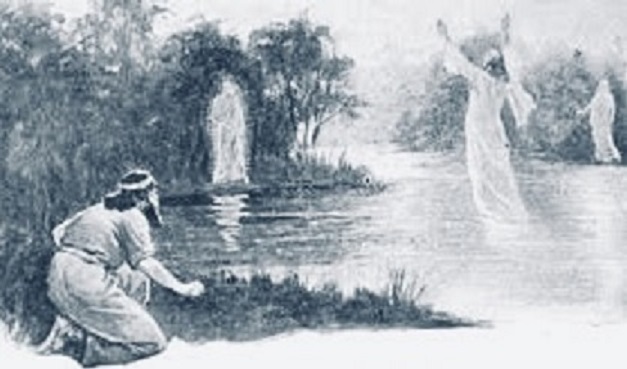This article is part of a series on Old Testament Christophanies. For important background information, see An Introduction to Old Testament Christophanies–with Justin Martyr.

The angel continued to speak to Daniel, relating to him one of the most detailed prophecies in the Bible. In Daniel 11:2–45, the angel spoke of conflicts that would come in the relatively near future, with a focus on Antiochus IV Epiphanes (11:21), and conflicts that are still yet to come, with a focus on the Antichrist (11:36).[1] The prophecy concluded in Daniel 12:1–4. In these verses we learn that at the time of the end, Michael, the great prince who stands guard over Daniel’s people, will arise to defend them. And there will be a time of distress, greater than there has ever been in the nation’s history. At that time, everyone among Daniel’s people who is written in God’s record book will be rescued. Many will be resurrected, some to everlasting life and some to everlasting contempt. Those who were wise by remaining faithful to God and those who led many to righteousness will shine brightly forever. The angel concluded by telling Daniel to preserve this revelation until the time of the end. Closer to the time of the prophecy’s fulfillment, many would study what Daniel had written and understand the meaning.
Soon after the prophecy had ended, Daniel saw two individuals, one standing on each side of the Tigris River (v. 5). These two were undoubtedly angels. The two angels may have been Michael and Gabriel since they are both mentioned by name in Daniel 8–12. Daniel described one of the angels speaking to a third person:
And one said to the man dressed in linen, who was above the waters of the river, “How long will it be until the end of these wonders?” I heard the man dressed in linen, who was above the waters of the river, as he raised his right hand and his left toward heaven, and swore by Him who lives forever that it would be for a time, times, and half a time; and as soon as they finish shattering the power of the holy people, all these events will be completed (Dan 12:6–7).
The glorious man in linen, the Son of God, had returned—and He was standing on or above water! Benson explained that this man in linen was the same man in linen from Daniel 10:5, and that He was “the Son of God, our High-Priest, who rules the nations, of which standing upon, or above, the waters, was an emblem: see Ps. xxix. 10. As a figure of this, Christ, in the days of his flesh, walked upon the waters, Matt. xiv. 25.”[2] In Psalm 29:10, we read that Yahweh sat as King over the worldwide flood (when He judged the nations), and He continues to sit as King forever. Benson’s point is that Yahweh the Son stood above the water of the river to demonstrate His authority as King over the nations, and that in Matthew 14:25, Jesus walked on water for much the same reason. It should also be said that the Son stood above water before and after the Incarnation to demonstrate His authority over creation.
The man in linen stood farther away from Daniel than He had before, which is presumably why Daniel didn’t faint. It could also be that the Son of God suppressed His glory enough so that Daniel could learn directly from Him. The Son’s appearance here suggests that it was He who earlier called out to Gabriel from between the banks of the Ulai Canal in Daniel 8:16. The fact that the angel sought answers from the man in linen led Calvin to think that He may have been Christ: “We know there is but one teacher of men and angels,—the Son of God, who is his eternal wisdom and truth. This passage may be referred to Christ . . .”[3] We may understand the man in linen swearing by “Him who lives forever” as the Son swearing by the Father in heaven. Yahweh had previously sworn by His own name since He could swear by no one greater (Gen 22:16; Heb 6:13). Instead of raising only one hand toward heaven, the man in linen raised both to emphasize the truth of what He was about to reveal. The “shattering” of “the power of the holy people” refers to the persecution of the Jewish people under the reign of the Antichrist. This period of persecution would last for a “time, times, and half a time,” a period of three and a half years (see Dan 4:16; 7:25; Rev 11:2–3; 12:6, 14; 13:5).
Daniel struggled to understand what this revelation meant, so he asked the man in linen what the outcome of these things would be. Daniel was told that the words were preserved until the time of the end. The coming persecution would lead to many being purified through faith. The wise would understand the words but none of the wicked would understand. The man in linen further said that from the time the daily sacrifice is abolished and the abomination of desolation is set up, there would be 1,290 days, and that those who remain until the end of the 1,335 days would be blessed (vv. 8–12). The “abomination of desolation” refers to the Antichrist desecrating a future temple in the middle of a seven-year period (Dan 9:27; see 2 Thess 2:3–4). Jesus said the abomination of desolation would mark a time of “great tribulation,” worse than any time since the beginning of the world and worse than any time there ever would be (Matt 24:15, 21). We can only speculate as to how the 1,290 days and the 1,335 days are meant to be understood in relation to the three and a half years. There are 1,260 days in three and a half years (forty-two months of thirty days per month), which is thirty days short of 1,290 days. It could be that the Antichrist will desecrate the temple thirty days before the three and a half years begin. The 1,335 days extends forty-five days beyond the 1,290 days. These extra days seem best understood as a period of transition from the time Jesus returns at the end of the 1,290 days to the inauguration of the millennial kingdom. Thus, those who make it to the end of the 1,335 days will be “blessed” to enter the kingdom.
The Book of Daniel ends with the man in linen telling Daniel to go and live his life, and then to “enter into rest and rise again for your allotted portion at the end of the age” (v. 13). Jesus said that the “voice of the Son of God” will raise the dead; some will come forth to a resurrection of life, while others will come forth to a resurrection of judgment (John 5:25, 28–29). The One who assured Daniel that he would be resurrected, is the same One who will call forth Daniel to a resurrection of life.
Daniel was told about great troubles and distress to come for the Jewish people, especially near the end of the age. But eclipsing the bad news was the good news that those who remained faithful to God would be rescued and His people would be resurrected to life. There will be no epic battle between Christ and the Antichrist. The very appearance of the true Christ at His coming will put an end to the Antichrist; the Lord Jesus will slay the “lawless one” (the Antichrist) with the breath of His mouth (2 Thess 2:8; see Rev 19:20). And Jesus Christ will resurrect the “many” in Daniel 12:2. By standing above the water, the Son of God made it clear that it was He, and not the Antichrist or any other ruler, who truly reigned over the nations and creation itself.
[1] Antiochus IV Epiphanes (ca. 215–164 BC), the little horn in Daniel 8:9–12, foreshadowed the Antichrist, the little horn in Daniel 7:8 (see Dan 8:23–26; 9:24–27).
[2] Benson, Notes, vol. 3, Dan 12:5–6.
[3] Calvin, The Book of the Prophet Daniel, vol. 2, Dan 12:5–7.

Leave a Reply